Glassnode: The Shanghai upgrade is complete. How much selling pressure will the unlocked ETH bring?
Original: 《Simulating Shanghai Sell-side: Investigating the Ethereum Unlock》
Author: Alice Kohn
Compiled by: Katie Gu, Odaily
The highly anticipated Shanghai/Capella hard fork took place this morning, allowing staked ETH to be withdrawn.
This article evaluates the potential sell-side pressure that may arise from the unlocking of staked ETH from the perspective of stakers and discusses the estimated amount of staked ETH that may be withdrawn and sold immediately after the Shanghai upgrade. After examining different staking groups and their motivations for selling unlocked ETH, we estimate that a total of 170,000 ETH will be sold after the Shanghai upgrade.
By viewing staked ETH from the perspective of depositors and categorizing it into different groups, we identified the groups most likely to create sell-side pressure. The majority of the unlocked staking rewards are expected to come from users redeploying to liquid staking providers, and these providers are unlikely to sell due to the loss incurred from selling. Currently, only 253 depositors are waiting to exit their staking, which is a very small proportion. Most of them are individual stakers or early stakers on the Beacon Chain. We believe they are most likely to have high conviction, and their withdrawal is more likely related to changes in their technical setup rather than exiting their positions.
We expect that only 100,000 ETH (190 million USD) of the total accumulated rewards will be withdrawn and sold. Additionally, we anticipate that twice as many validators will exit, but only a limited amount of staking will be released each day. We believe that only a small portion of this, around 70,000 ETH (133 million USD), will become real liquidity.
The economic impact of this situation will last for several days to weeks. According to our analysis, the impact on the Ethereum economy is expected to be much smaller than many have predicted. It can be argued that the technological delivery of the upgrade is more likely to support a growing staking industry that seeks to better serve Ethereum holders in the long term.
Shanghai Upgrade
The highly anticipated Shanghai/Capella hard fork began on April 12, 2023, and will allow ETH funds from Ethereum's new PoS consensus mechanism to be withdrawn. The earliest deposits were made in November 2020, prior to the launch of the Beacon Chain, and until now, stakers have not been able to access their staked ETH or accumulated rewards.
Some stakers have been active since the Beacon Chain, with rewards accumulating for over two years, accompanying the market through a full bull/bear cycle. This has raised speculation about the potential market impact as approximately 18 million ETH (33.92 billion USD, accounting for 15% of the total circulating supply of ETH) is unlocked, affecting supply. There are concerns about whether this unlocking will flood the market and temporarily create significant sell-side pressure on ETH.
The purpose of this article is to assess the staking landscape of ETH, develop a framework for staking groups, and evaluate the potential impact of the Shanghai hard fork. We conducted several simulations to answer the following questions:
- Who is most likely to withdraw staked ETH?
- What is the expected amount of staked ETH to be withdrawn?
- How much sell-side pressure do we expect these withdrawals to create?
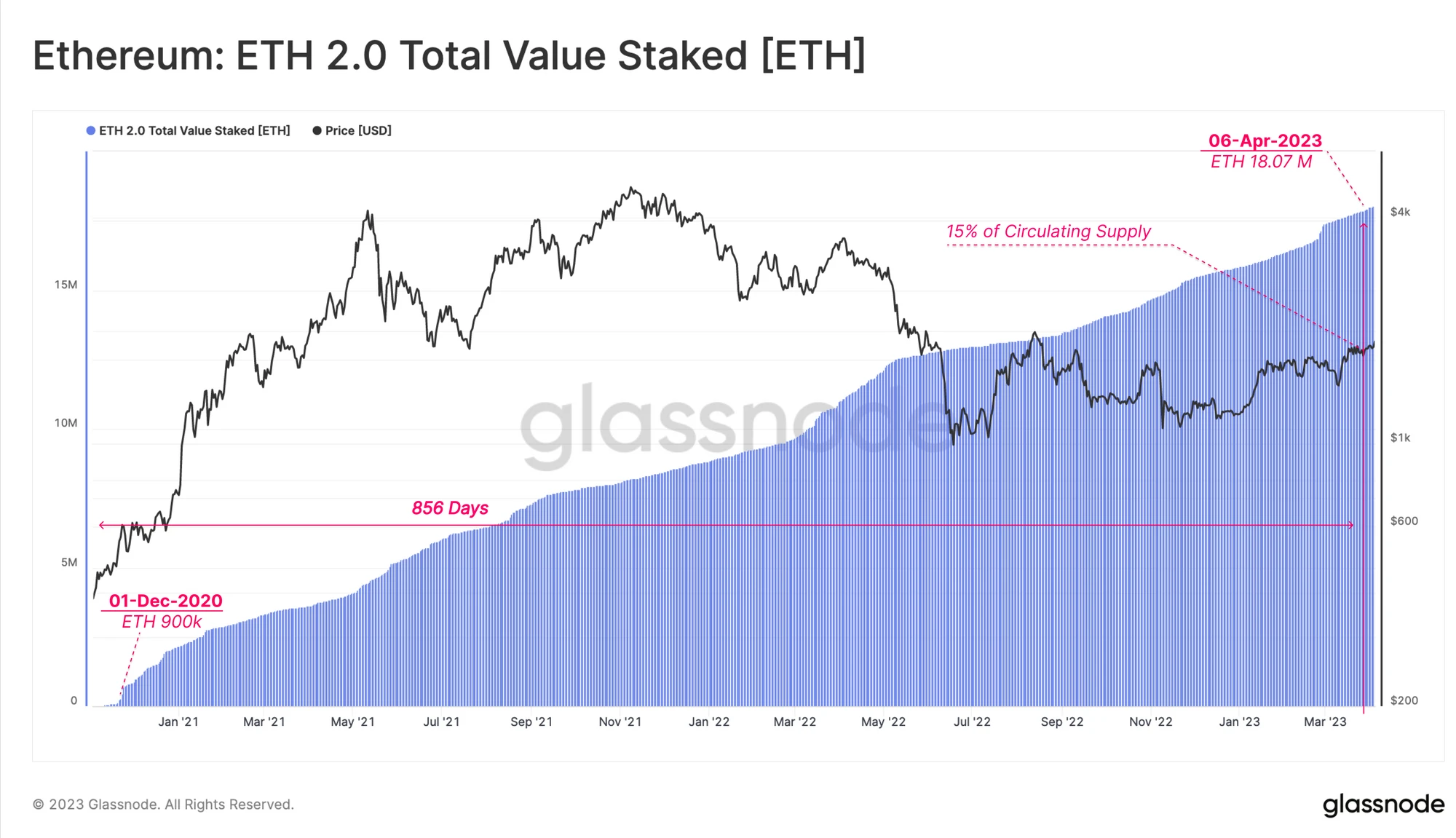
Ethereum Staking Landscape
To gain a comprehensive understanding of the current staking landscape, we will provide a brief technical overview of the existing participants in Ethereum's Proof of Stake (PoS) consensus mechanism:
- Depositors are private individuals or entities that send 32 ETH to activate a validator. A depositor can have multiple validators staking 32 ETH on their behalf.
- Validators are virtual entities located on the Beacon Chain that serve Ethereum's consensus layer. They can be viewed as private keys and balances, all recorded on the consensus layer. Validators are pseudo-randomly selected to verify and guarantee the validity of transactions and the information included in blocks. Sometimes, they are assigned to propose block proposals, which bundle these transactions. Upon completing their work, validators receive ETH staking rewards, which are divided into consensus layer block rewards and execution layer fees (only priority fees flow to validators, while base fees are burned).
- Nodes are physical hardware running validator software. Each node can accommodate multiple validators. Nodes can be operated by depositors themselves or delegated to third-party staking service providers.
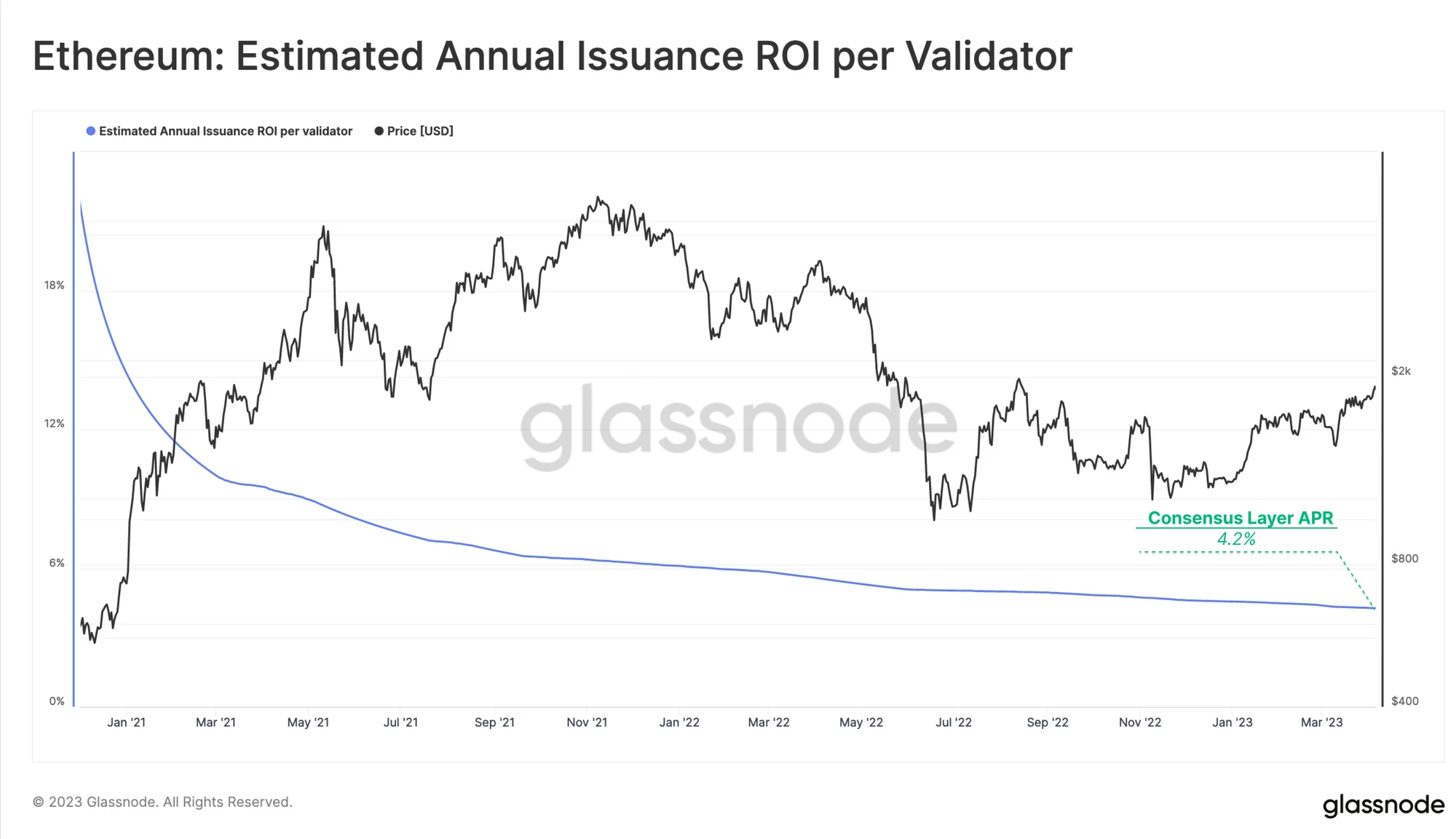
Depositors as Key Participants
A significant amount of research has been conducted on Ethereum's staking economy, with most focusing on validators as the primary participants. For our analysis, we believe it makes more sense to focus on depositors, as they can own multiple validators and ultimately make decisions about withdrawing funds and their usage at the depositor level.
To understand the Shanghai/Capella upgrade, we will categorize depositors into different groups based on the expected demand for ETH and their staking or non-staking motivations. The following diagram illustrates our chosen segmentation, primarily considering four factors:
- Depositor participation time: the length of time staking has been active.
- Depositor scale: the number of validators owned.
- Depositor profitability: unrealized profits/losses among owned validators.
- Organization: divided into individuals (individual stakers) or third-party staking providers.
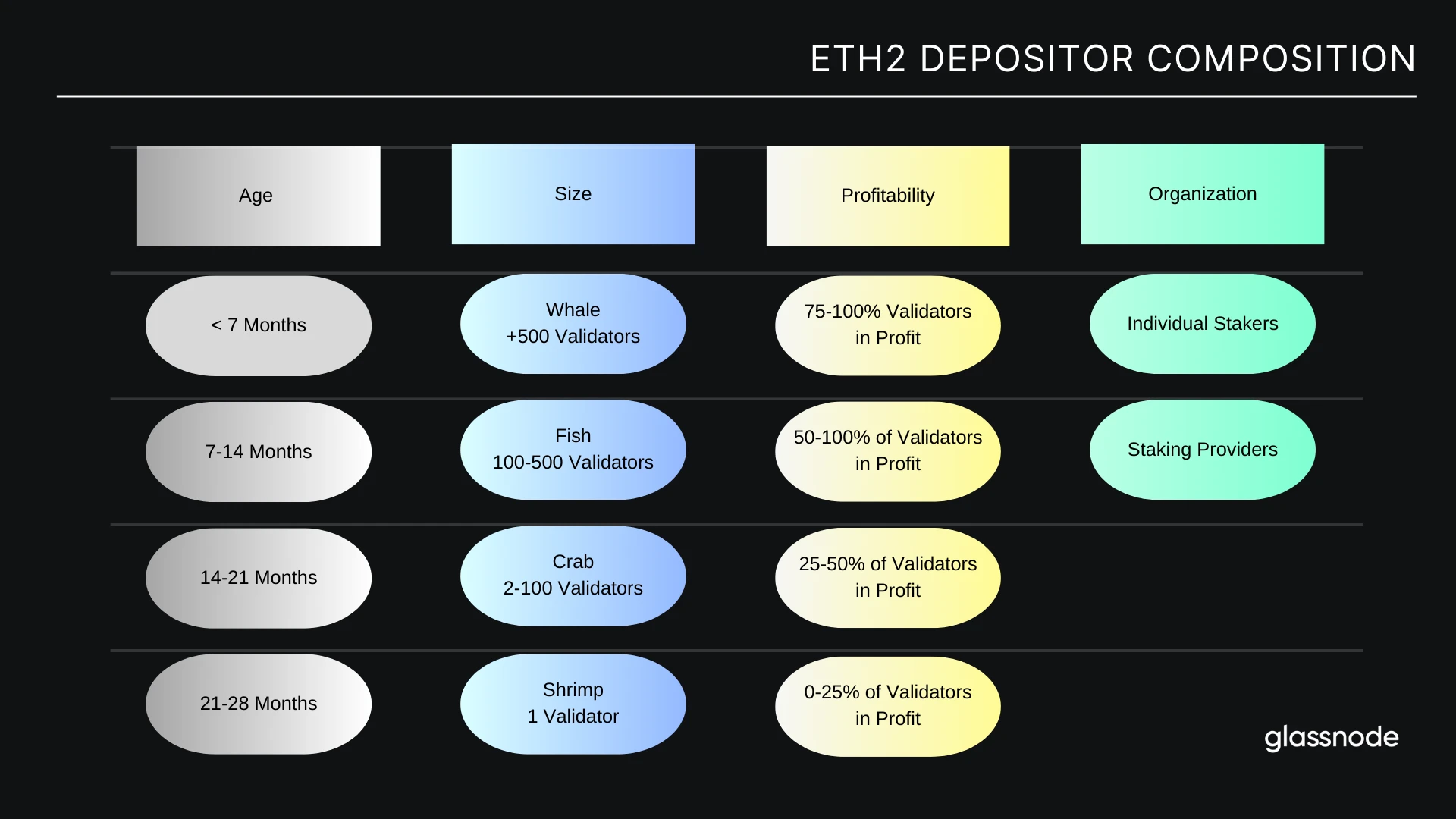
Please note: We understand that individuals or entities may use different depositor wallet addresses to deploy staking to the network. This often occurs with providers offering staking services. Therefore, we separated depositor addresses belonging to these providers from the dataset and analyzed them separately. This is to prevent any erroneous predictive signals from our analysis.
Private Stakers vs. Institutional Stakers
When clarifying the staking landscape, it is important to distinguish between private stakers and institutional/staking provider depositors, as the former have their own technical setups. In the chart below, we excluded staking providers, as many of these entities use one-time addresses for deposits, which distorts the real data.
Based on the daily deposit numbers, we can differentiate between one-time depositors and multiple deposit wallets. We can see that one-time depositors are mainly active during significant events, such as the launch of the Beacon Chain and the Merge, as well as the current expectations for the Shanghai upgrade, indicating their confidence in the system. Events on the execution layer, such as the collapse of Terra and its ripple effects, did not affect the storage situation.
We also noted that staking pools are primarily composed of multiple betting depositors, thus holding multiple validators. We can see that some of these recurring depositors have over 1,000 deposits daily. Interestingly, during the bull market of 2021, these new deposits on the Beacon Chain experienced a relative "off-season."
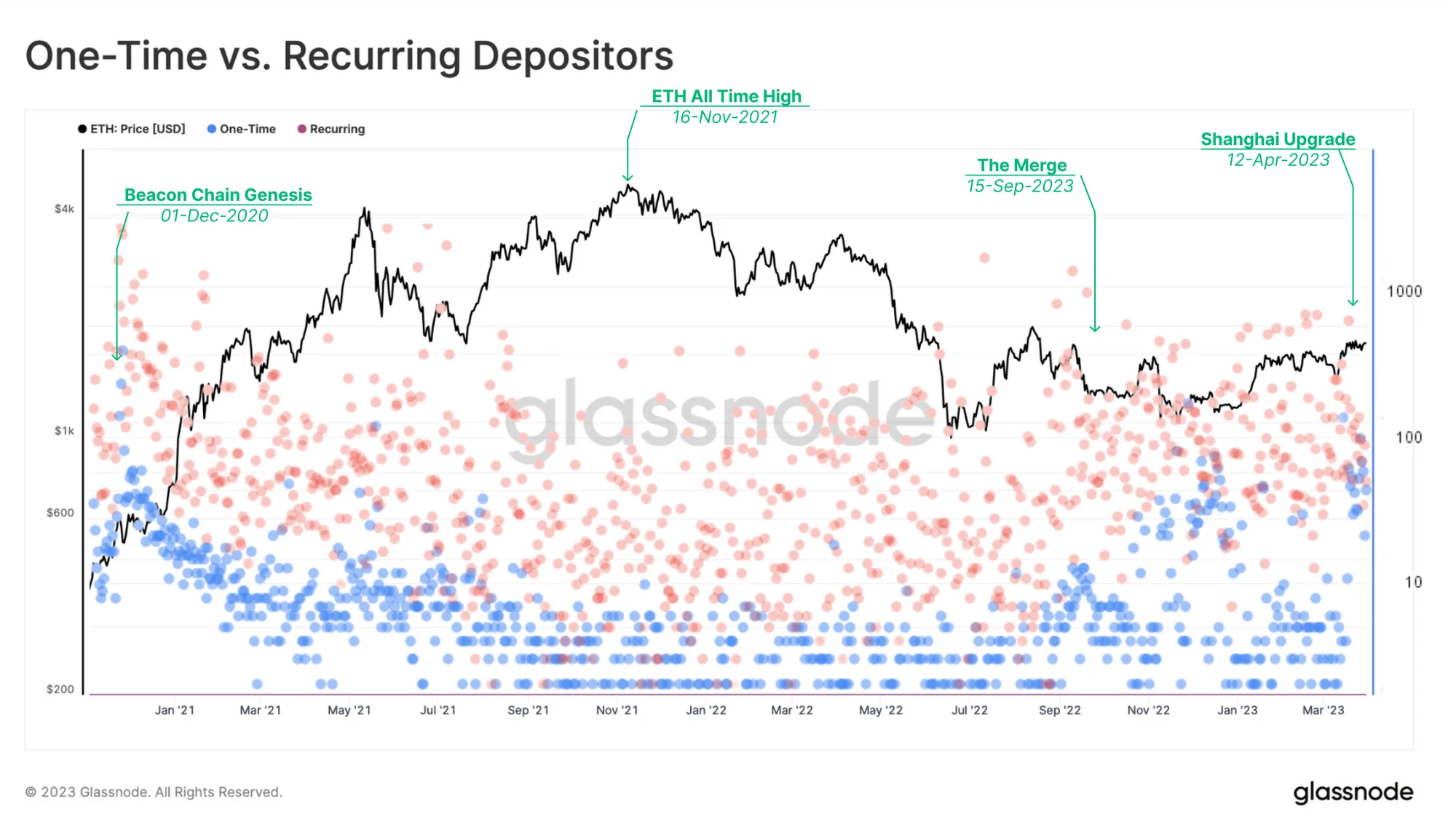
Staking Providers
Staking providers are larger entities that allow users to delegate their ETH to the provider's validator nodes. By delegating ETH to these nodes, users can earn rewards for supporting the network without running their own validator nodes or providing the full 32 ETH.
Over the past two years, liquid staking providers have gained significant market share, returning tradable token derivatives to users. Currently, Lido is the market leader, holding over 30% of the total network staking market share. Centralized exchanges like Coinbase, Kraken, and Binance follow closely, with market shares of 11.5%, 7.0%, and 5.4%, respectively.
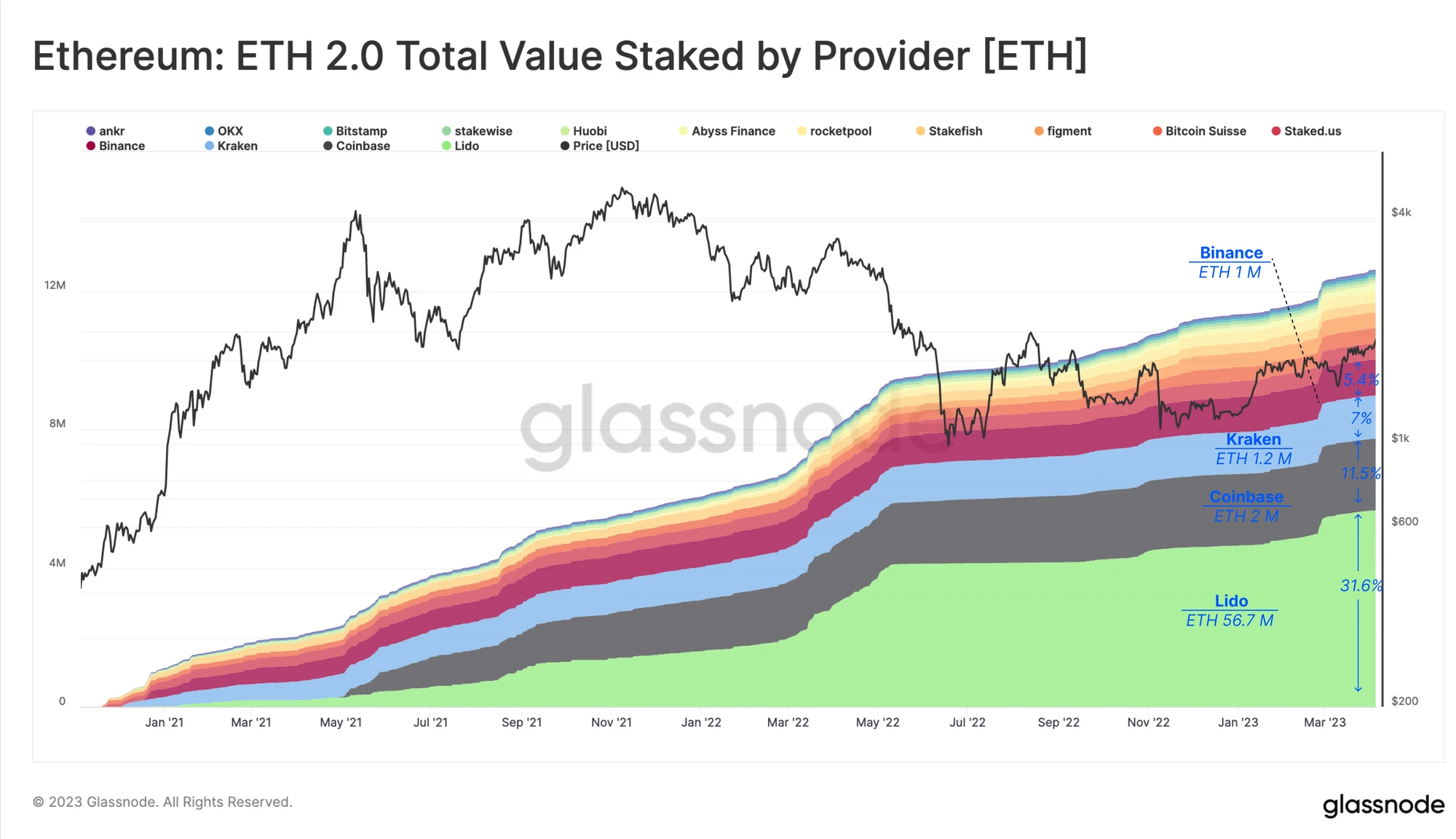
A close examination of the deposit amounts from various staking providers over time clearly shows a shift in dominance:
- In the first six months after the birth of the Beacon Chain, Kraken and Binance were the main depositors. However, they were eventually surpassed by Coinbase and Lido.
- Lido's dominance expanded significantly in the second half of 2021, yet the stETH token faced market pressure during the LUNA-UST collapse and the bankruptcies of Three Arrows Capital and Celsius. This was due to these entities having substantial associations or positions in that token at the time.
As a result, deposit activity across all staking providers, particularly Lido, sharply declined in mid-2022 and slowly "recovered" by the end of the year. Additionally, we observed a significant shrinkage in staking activity from centralized exchanges due to increasing pressure from U.S. regulators on these institutions. After being fined by the U.S. Securities and Exchange Commission (SEC), Kraken ultimately ended its staking services in the U.S. in February 2023, while Coinbase received a notice in March 2023 regarding its staking services violating securities laws.
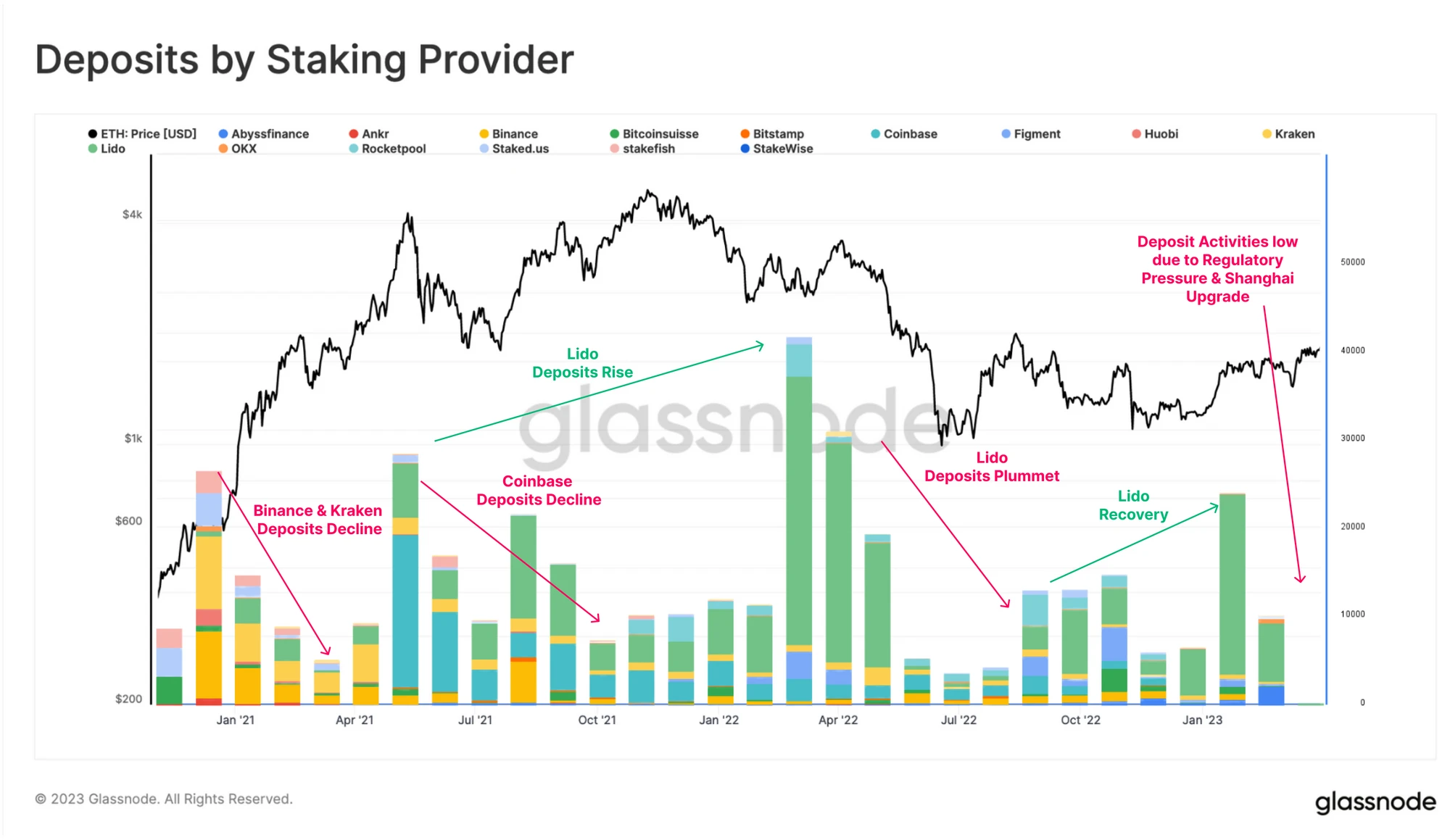
Depositor Participation Time
Depositor participation time is calculated based on the deployment date of validators to determine the average time depositors have been involved in the staking economy. This includes both one-time and recurring depositors, but again excludes staking providers.
We then categorized depositors into five data bins reflecting a quarter of the Beacon Chain's lifespan (7 months per bin), with one data bin representing depositors before the launch of the Beacon Chain. To our surprise, we detected a relatively large group of 25,000 depositors whose average deposit time predates the launch of Ethereum's consensus layer. We categorize these depositors as high-conviction investors in Ethereum, as deploying validators at that time was a significant risk. We even believe that these depositors do not view validators as an investment but rather as members within Ethereum or the community, motivated to ensure the network's security rather than to generate profits.
Additionally, we can see that most depositors' deposit times fall between 6 months to 1 year. This indicates that over the past year, confidence in Ethereum's staking economy has grown, particularly following the successful execution of the Merge and the recent enabling of withdrawals.
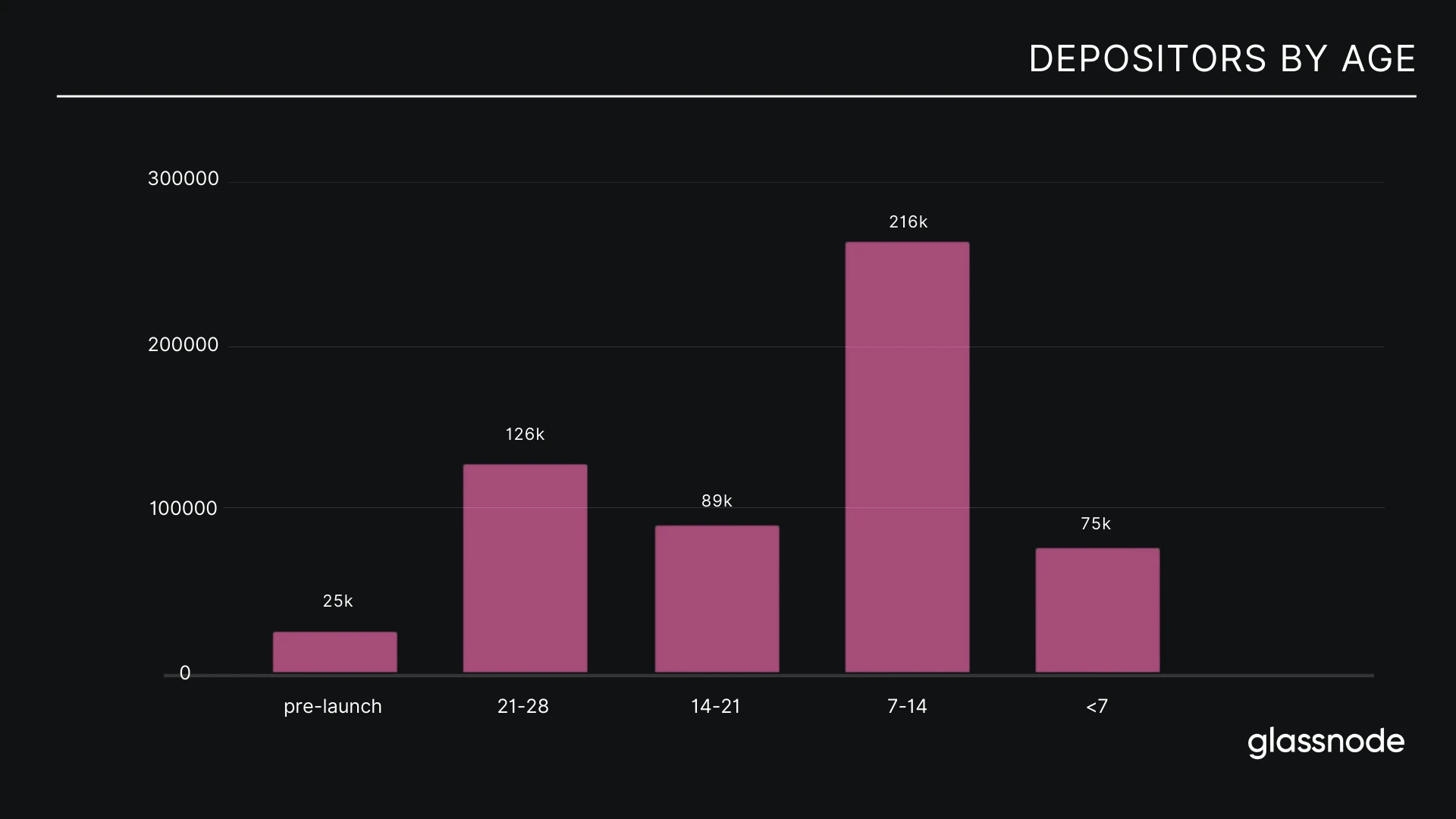
Depositor Scale
The next step is to examine the scale of individual depositors, again excluding staking providers from our dataset. Unlike the previous chart, which calculated individual deposit events, here we calculate the total number of validators accumulated by depositor wallet addresses over time. We then categorized these into different sizes of data bins.
Notably, six months after the launch of the Beacon Chain, the staking pool was divided between depositors holding only one validator (shrimp users: users with holdings relative to whales) and those holding over 500 validators (whales). During the previous bull market, the number of one-time depositors was relatively high. However, during the market turmoil of 2022, the number of one-time depositors sharply declined due to new individual stakers hesitating to enter the staking pool.
The dominance of "crab" users holding 2 to 500 validators and "fish" entities (users with holdings relative to whales) is surprisingly small, accounting for only 13.5% of the total.
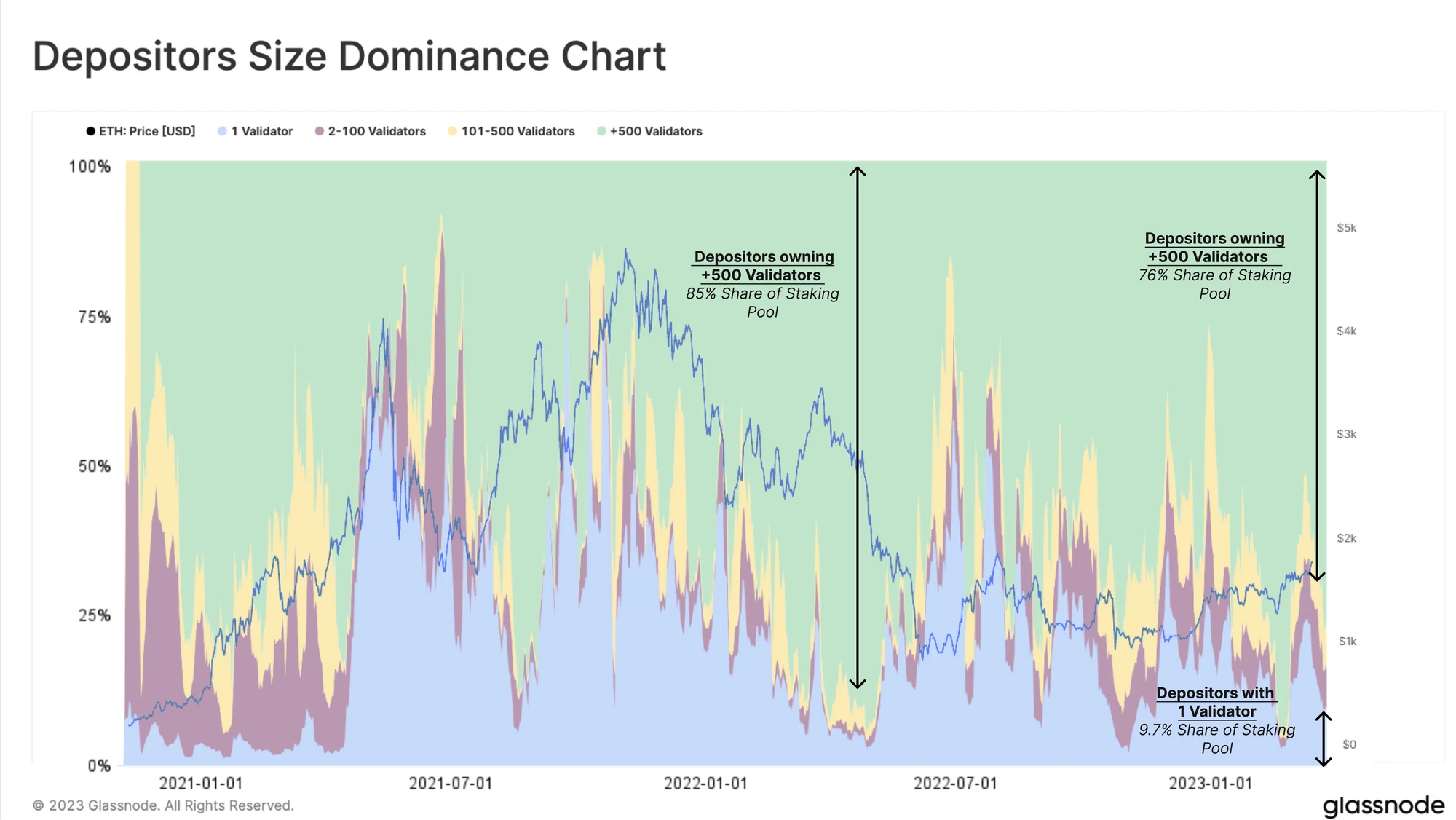
Depositor Profitability
To assess depositor profitability, we calculate the realized price of their staked ETH, comparing the ETH value at the time of deposit to the current spot price. This provides a standard for measuring the average unrealized profits/losses held by each depositor.
Currently, the average deposit price for all staked ETH is $2,136, indicating an average unrealized loss of -13% at the current spot price. In contrast, the realized price for the Ethereum network is $1,403, with unrealized profits of +36%, capturing the average price at which the entire ETH supply last moved on-chain.
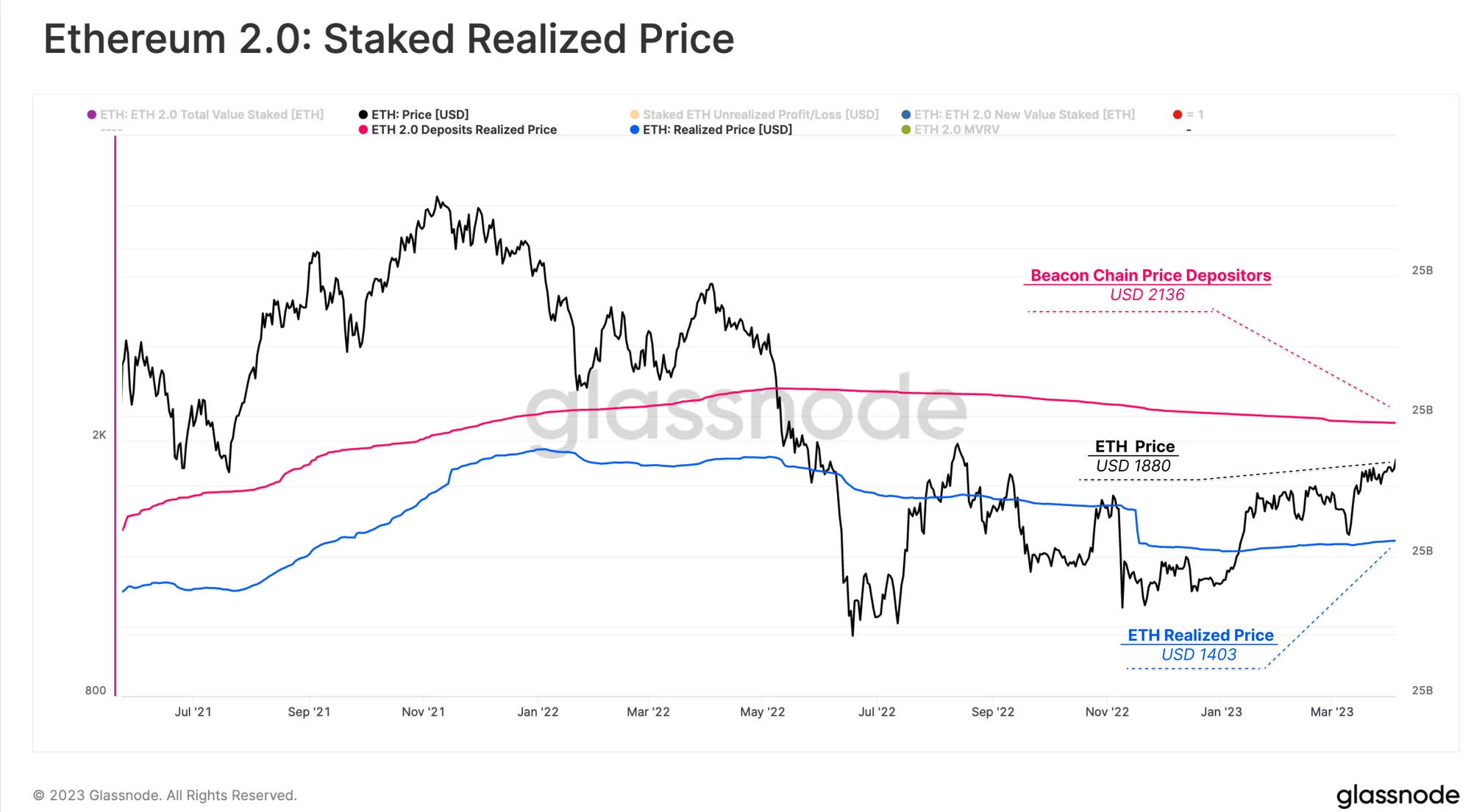
Upon examining the realized prices for each staking provider, we observe that the average cost basis for Coinbase and Lido is approximately 50% higher than the current ETH spot price. Binance and Kraken saw significant deposit activity at the start of the bull market, currently hovering around break-even levels between $1,812 and $1,900.
The high realized prices for Coinbase and Lido present an interesting dynamic, as both offer a liquid staking derivative for their staked ETH, allowing holders to sell or better hedge risks, potentially achieving better realized prices in the secondary market.
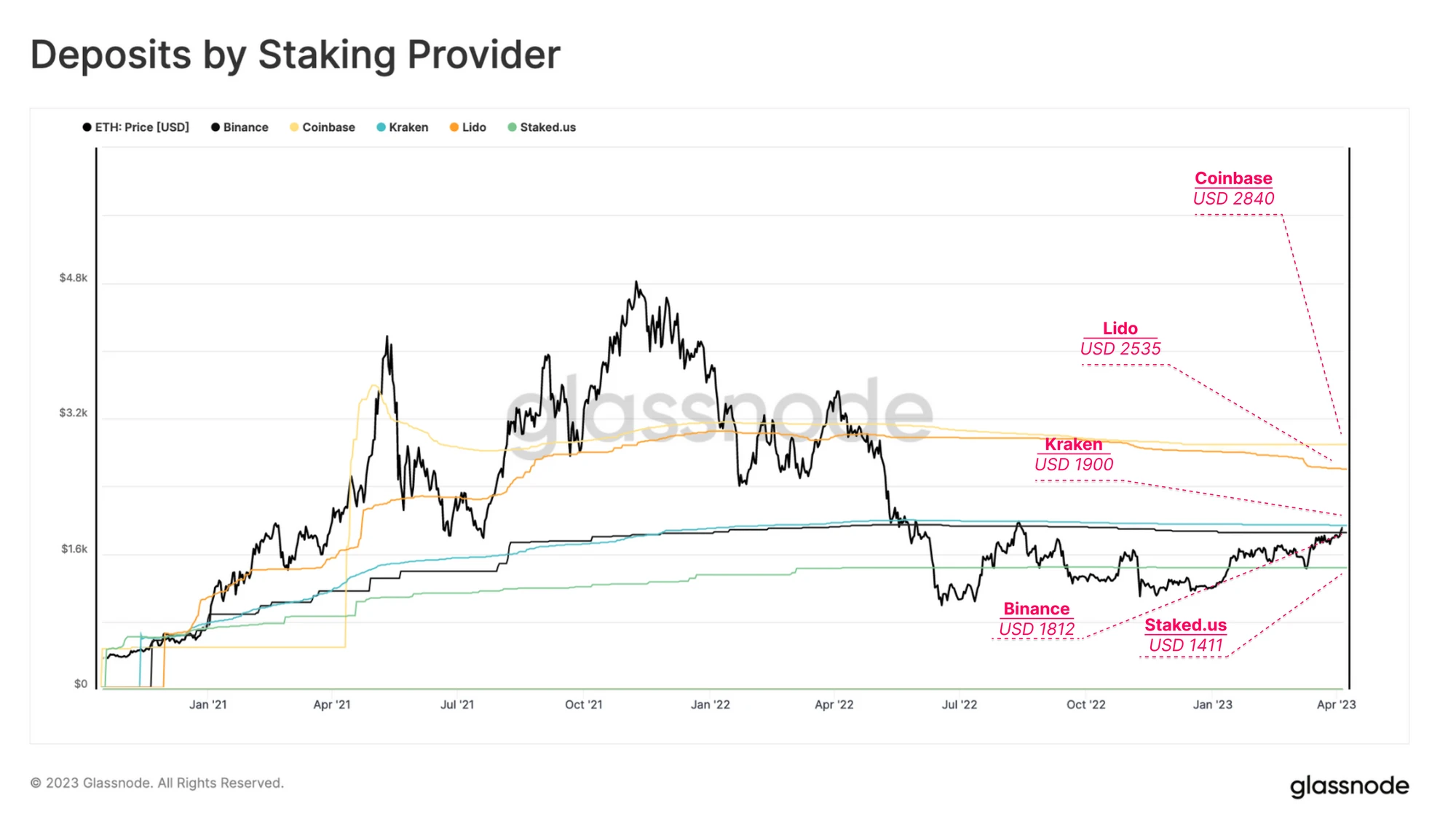
If the price of ETH at the time of deposit was lower than today's ETH price, we consider that stake to be at a loss. Indeed, the supply of ETH deposited during the peak of the bull market between mid-2021 and mid-2022 is held at unrealized losses. Currently, approximately half of the total staked amount is at a loss, signaling potential exits after the Shanghai upgrade.
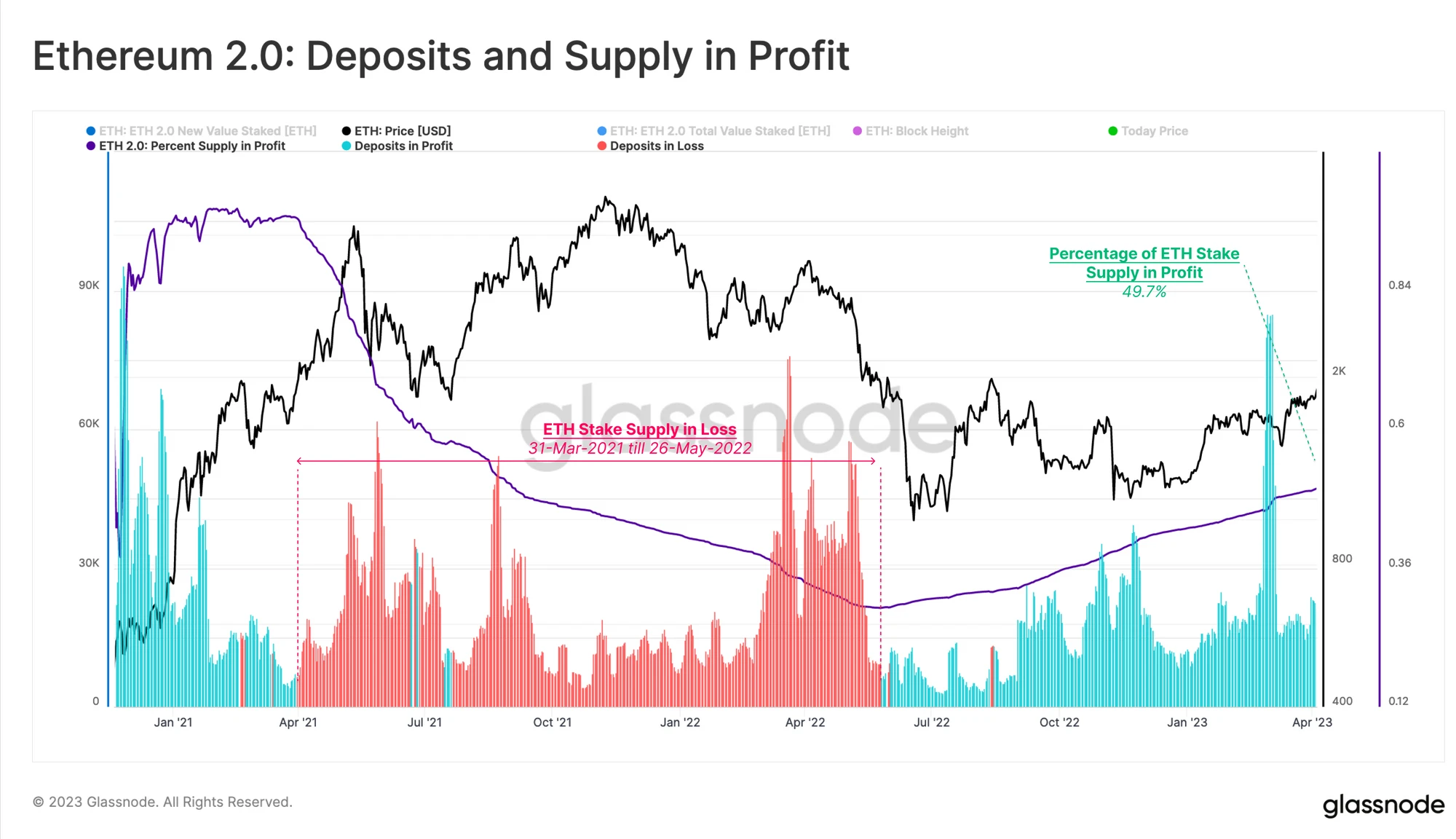
By utilizing the difference between the ETH spot price and the realized price of ETH deposits, we derive the total dollar value of unrealized profits or losses held by depositors. Combined with our categorization of depositor scale, we can begin to classify based on unrealized profits or losses between depositor types. After reaching a peak of $16 billion in unrealized losses in July 2022, the current net unrealized loss stands at $4.7 billion, primarily borne by whale depositors, who account for 76% of the unrealized losses.
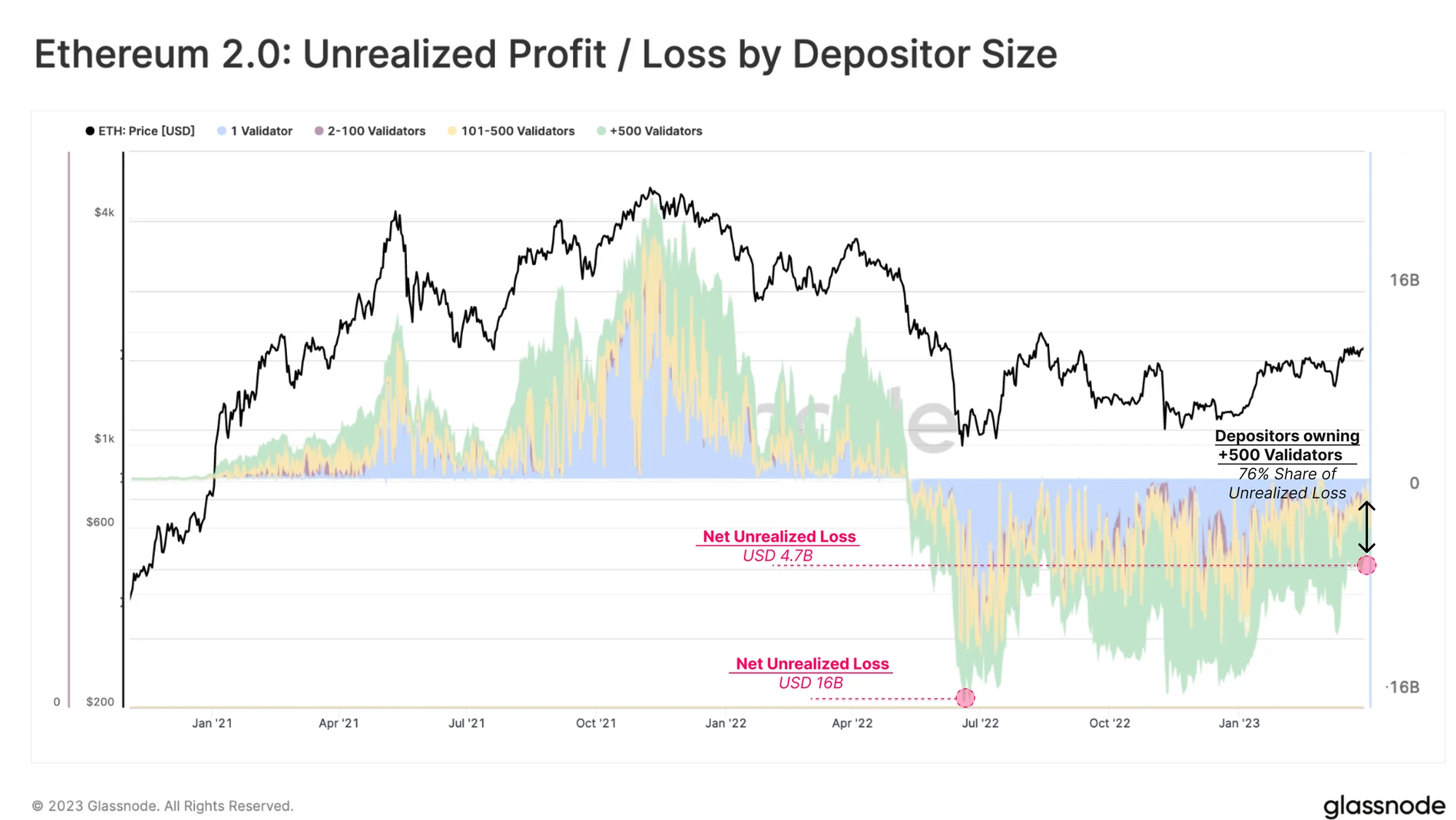
Simulating Withdrawal Scenarios After the Shanghai Upgrade
Next, we estimate the amount of staked ETH that may be withdrawn immediately after the Shanghai upgrade.
While depositors cannot withdraw their staked funds, they can still sign a voluntary exit message indicating their desire to exit the staking pool. Currently, there are 1,229 validators waiting to exit, along with 214 "slashed" validators that will be forcibly exited once withdrawals are enabled (totaling 46,176 ETH, 85.7 million USD).
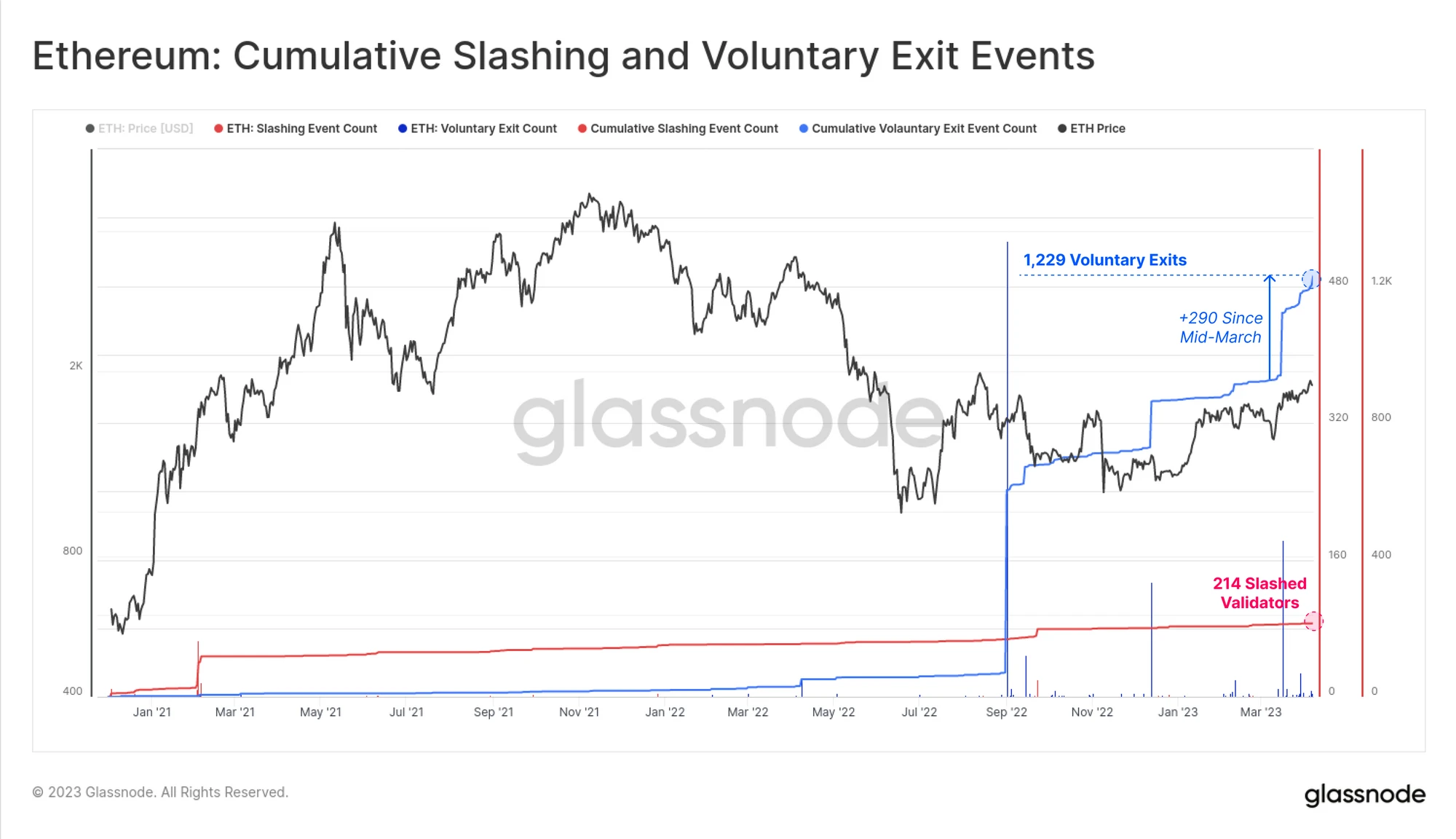
The Shanghai upgrade allows for two types of withdrawals: partial withdrawals and full withdrawals. Partial withdrawals (often referred to as skimming) automatically extract the accumulated staking rewards of each validator, reducing their validator balance to 32 ETH. Full withdrawals involve completely exiting the validator and reclaiming the entire staking balance.
Validators undergo the same automatic withdrawal processing for both partial and full withdrawals. The entire validator set is scanned linearly from index 0. If a validator has not signed a voluntary exit message or has been slashed, excess ETH balances will be extracted and automatically sent to the execution layer. If a validator has signed a voluntary exit and passed the waiting period, they will successfully exit. Each slot lasts 12 seconds, scanning and processing 16 validators. Given the current number of validators, this process could take up to 4.5 days.
However, the process becomes complex due to the need to update the withdrawal credentials of validators. Withdrawal credentials define where the withdrawn ETH is sent. In the early days of PoS, validators deployed with 0x00 credentials. To participate in the automatic processing, these validators need to update their credentials to 0x01 type. Currently, approximately 300,000 validators need to update their withdrawal credentials, which can only be achieved after the Shanghai/Capella upgrade. We recalculated the duration of the automatic process, and based on the actual number of validators eligible for partial withdrawals after the Shanghai upgrade, it could take a maximum of 2 days.
Predictions for Partial Withdrawals
The Shanghai upgrade is a unique case where rewards have accumulated over more than two years and will be unlocked all at once. Currently, there is an excess balance of approximately 1,137,000 ETH, valued at around 2.1 billion USD, that is not actively participating in PoS. After the Shanghai upgrade, this amount will be automatically extracted from the Beacon Chain and transferred to the depositors' Ethereum mainnet addresses as an updated automatic balance.
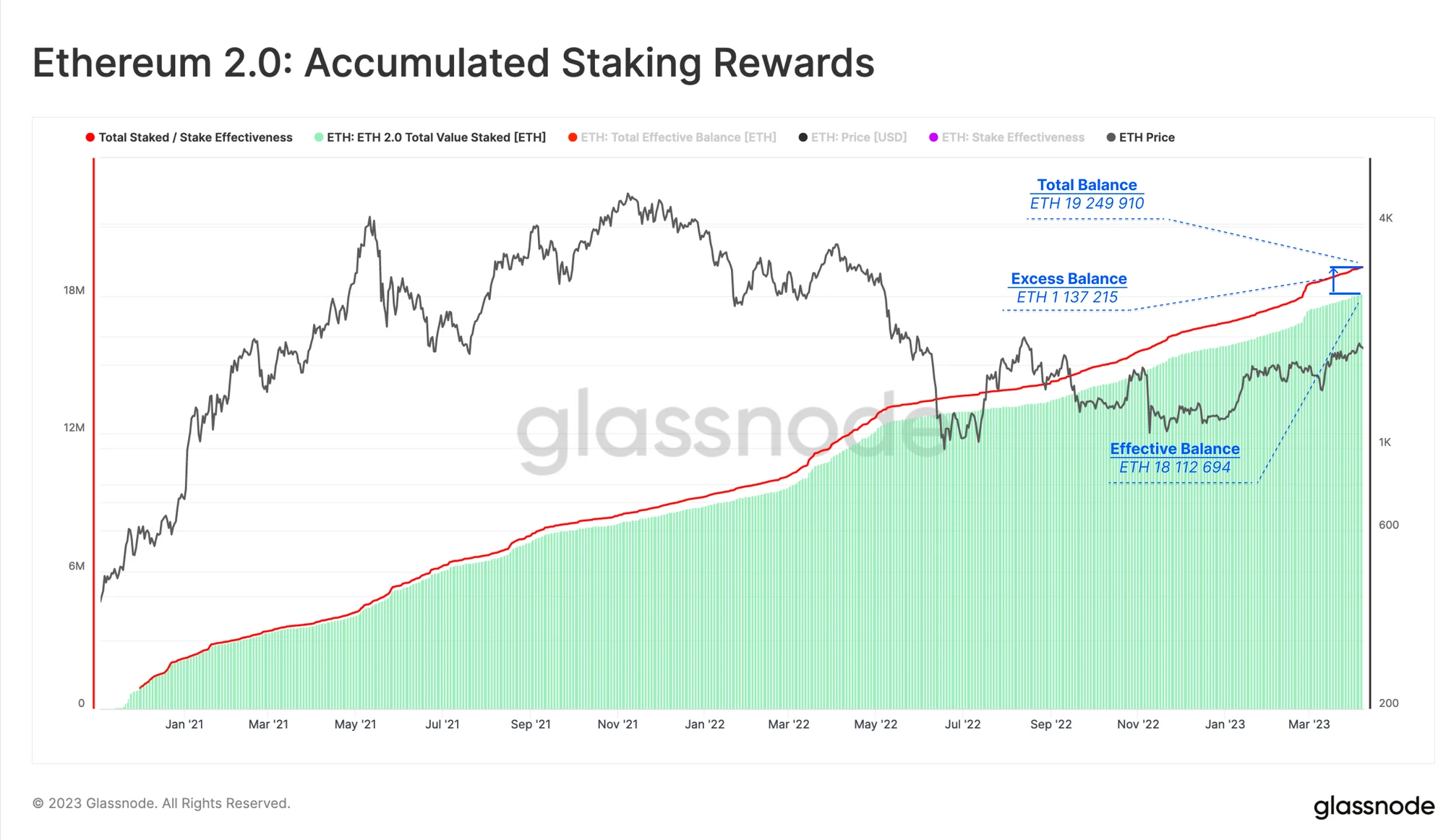
As mentioned above, only validators with 0x01 withdrawal credentials will participate in the automatic withdrawal process. Currently, about 44% of validators have the correct withdrawal credentials. However, many validators still need to update their withdrawal credentials, many of which were deployed in the early days of the Beacon Chain and have accumulated substantial staking rewards. Data Always conducted a detailed analysis of this, and we replicated the chart below to show how the number of validators with these two sets of credentials has evolved.
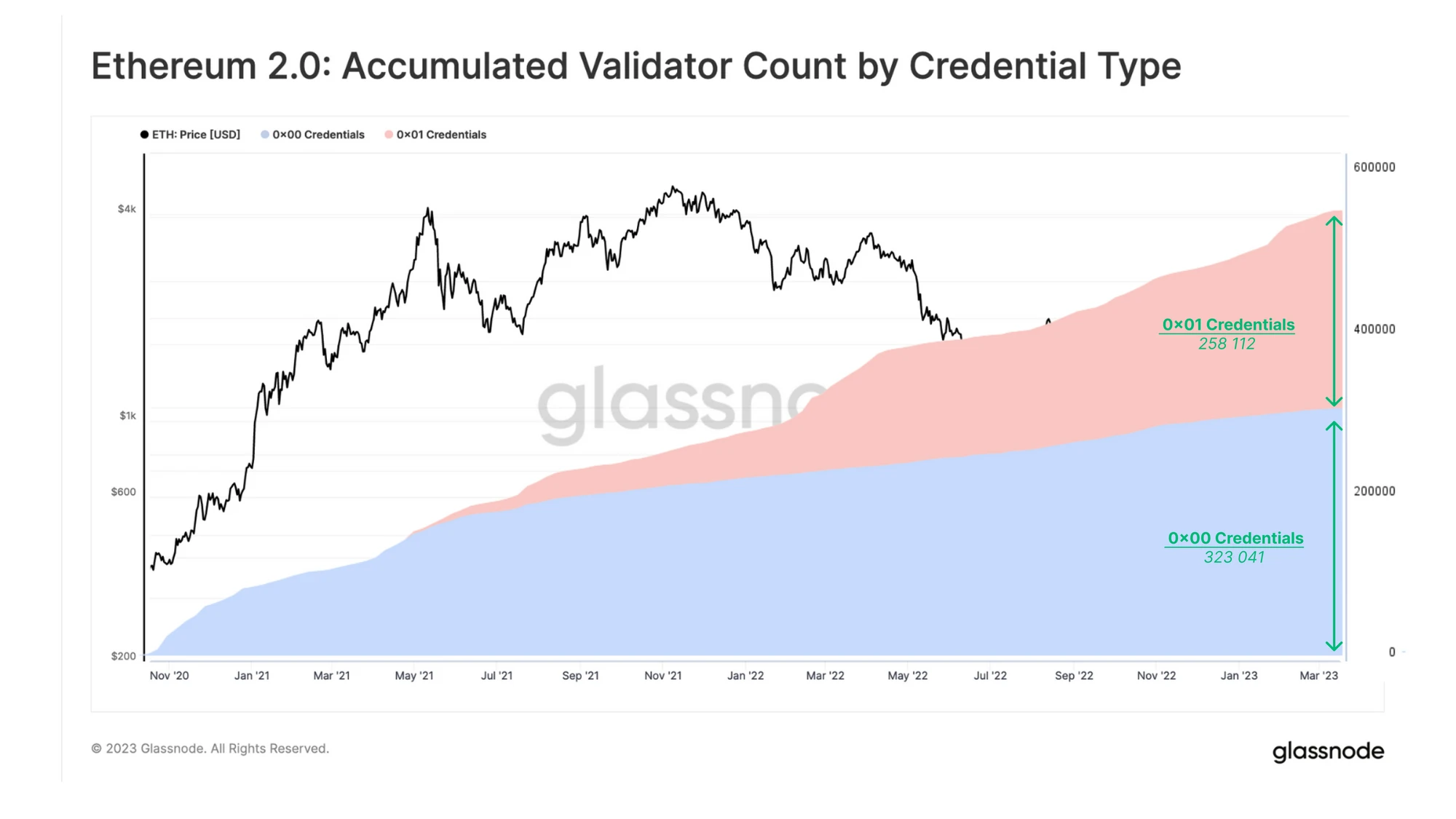
Data Source: Data Always
Based on the proportions identified in the analysis, validators with 0x00 credentials hold nearly 75% of the total accumulated rewards. Therefore, validators with 0x01 credentials will receive the remaining 25%, which corresponds to a withdrawal of 276k ETH within two days.
In an extreme scenario where all remaining validators update their withdrawal credentials after the Shanghai upgrade, this will occur at a rate of 16 validators per block, and we will ultimately see the entire 1,137,000 ETH withdrawn from the Beacon Chain within 4.5 days.
The following chart shows the minimum and maximum amounts of rewards paid, including the maximum daily ETH amount unlocked in each scenario. The actual numbers may fall between these extremes. We believe that many depositors may wait until the successful implementation of Shanghai to unlock their accumulated rewards before upgrading their withdrawal credentials, so we use a 50% withdrawal as a baseline. We expect the actual number of unlocked accumulated rewards to be closer to 706k ETH (131 million USD) as a minimum.
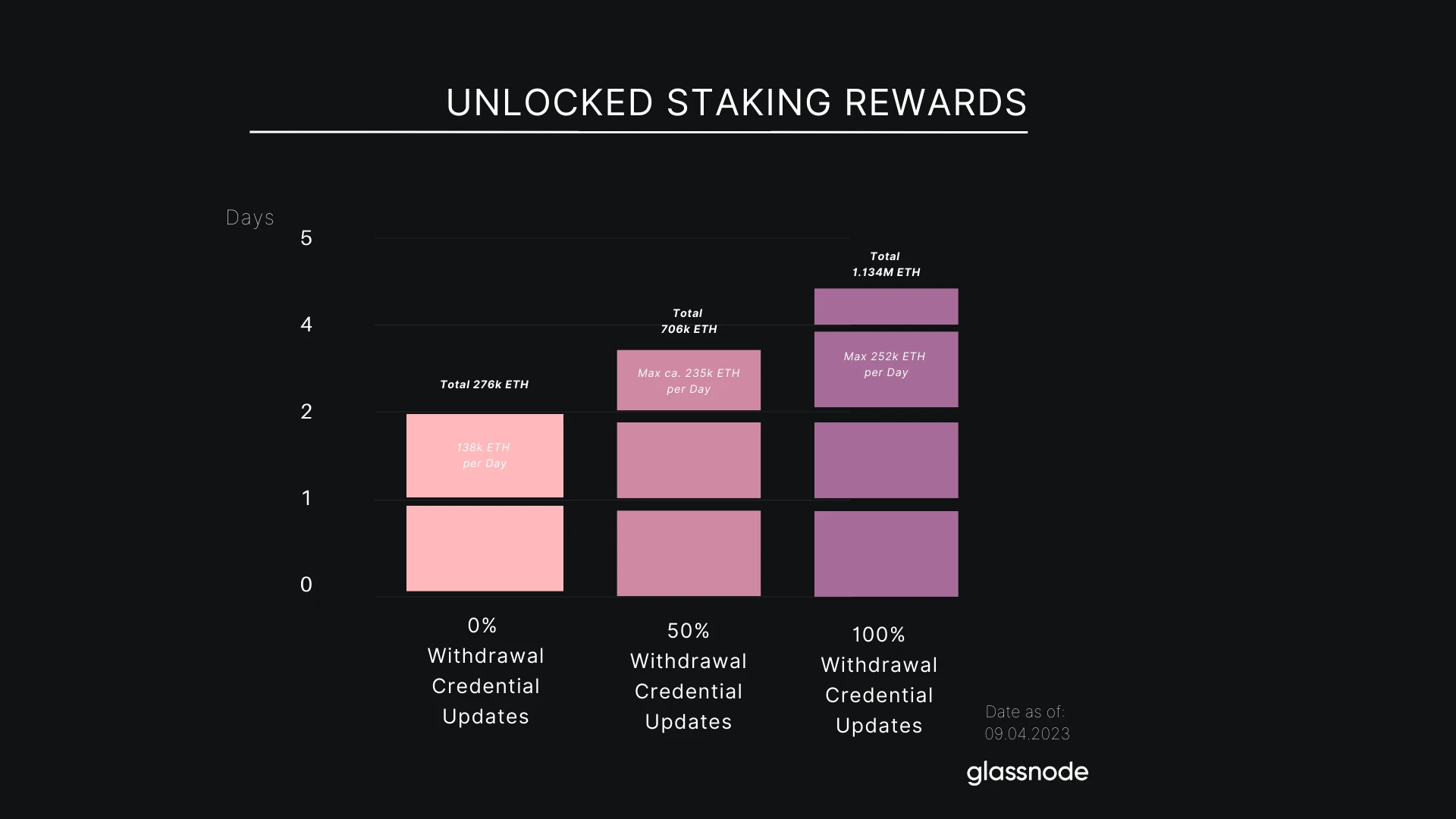
To estimate how much of the accumulated rewards will be sold, we analyze based on the depositor segmentation above. Since Lido holds a significant share of the accumulated rewards and has committed to re-staking the majority of the bonuses, we believe that other staking providers will follow suit, leading to a significant portion of the staking rewards being locked again.
We can also exclude the high sell-side pressure from the remaining groups. According to the depositor scale chart, about 75% of non-institutional depositors are large holders, owning over 500 validators or 16,000+ ETH in staking balance. Depositors with this financial strength are unlikely to feel sell-side pressure, even if their validators are nearly at a loss. Given the positive trend in the market over the past week, this group of depositors is more likely to choose to re-stake or reinvest their accumulated rewards and wait for the next bull market to arrive.
This leaves us with a potential range of 76k ETH (14.1 million USD), with a maximum potential of 162k ETH (300 million USD), as a measure of the potential sell-side pressure from partial withdrawals after the Shanghai upgrade.
Predictions for Full Withdrawals
When considering full withdrawals, it is important to note that only a limited number of validators can exit each day. Since the security of the Ethereum network relies on a stable set of validators, there are various mechanisms in place to prevent significant fluctuations in validators and the rapid depletion of staking. This daily number is defined by volatility, which determines the number of validators allowed to enter and exit. The volatility limit itself is related to the number of active validators in the staking pool.
With the current volatility limit of 8 validators per epoch and 225 epochs per day, a maximum of 800 validators can exit each day, equivalent to 57.6k ETH. From our historical data, we can see how the volatility limit interacts with newly entering validators.
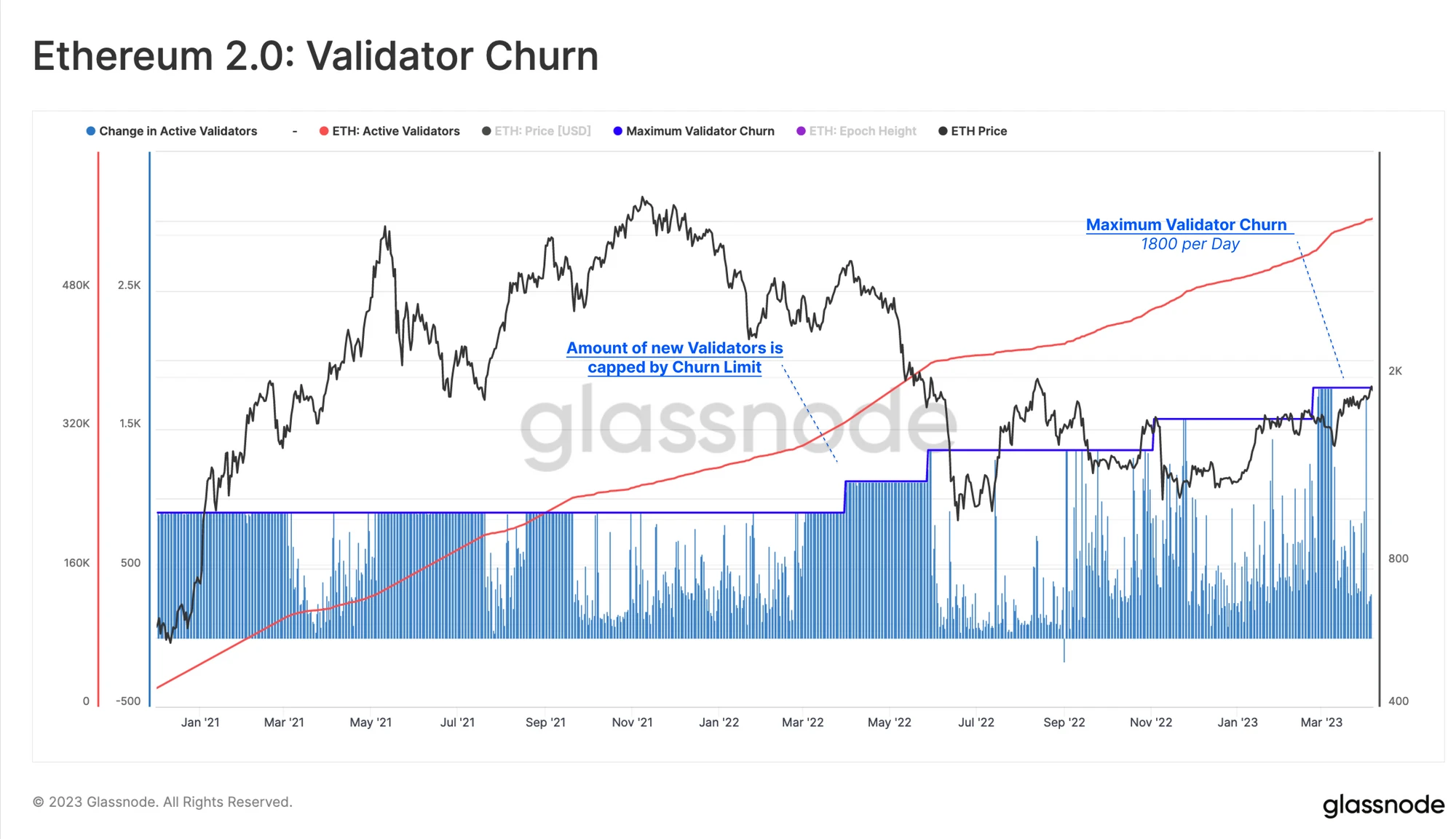
In addition to the exit period determined by the volatility limit, validators must also go through an exit capability delay. For voluntarily exiting validators, this waiting period is 256 epochs, or about 27 hours. For slashed validators, it is 8,192 epochs, or about 36 days. We then add the time for the automatic withdrawal process, as mentioned above.
Considering our data on exiting and slashed validators and the different waiting periods, we simulated the cumulative amount of ETH accessible after the Shanghai upgrade. After three significant increases in the number of validators signing voluntary exit agreements (one after the Merge in September 2022 and another this year), we currently see a cumulative total of 45,098 ETH (equivalent to 8.33 million USD) available for stakers.
As mentioned above, the staking exit process will take two days to withdraw the total amount from the Beacon Chain, meaning we will see at least 45,098 ETH (8.33 million USD) exit the Beacon Chain between April 12 and April 14.
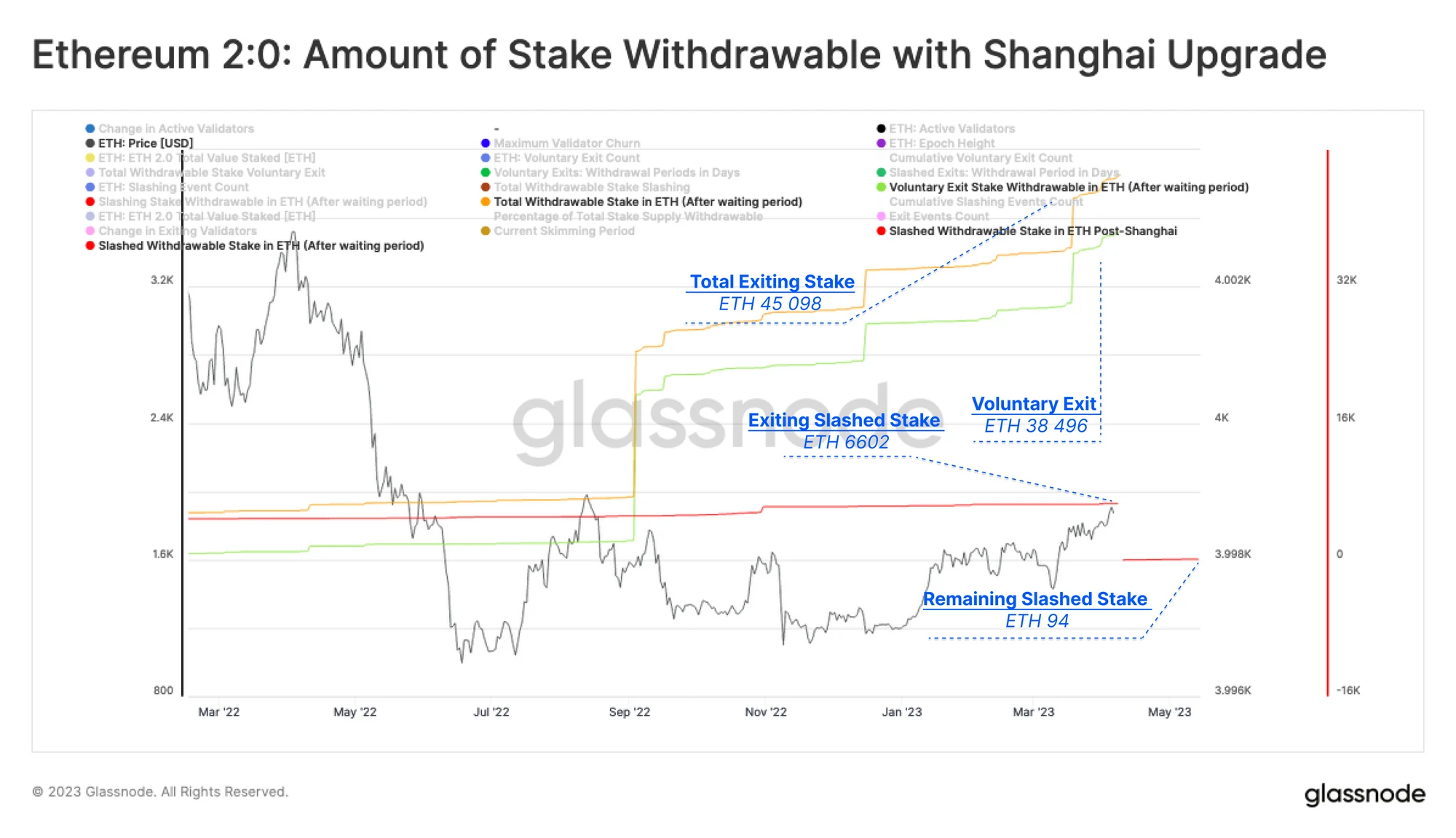
Looking back at our depositor classification table, we can now identify the composition of depositors likely to begin full withdrawals. We see that the validators that have exited belong to a total of 253 depositors. Notably, very few staking providers have withdrawn their validators. So far, among the largest staking providers, only Coinbase has announced that it will allow withdrawals immediately after the Shanghai upgrade. Lido is said to enable withdrawals in May, while Kraken and Binance have not announced dates yet.
Additionally, we see that the exiting depositors are primarily those with only one validator, as well as those who deployed their staking during the pre-launch phase or the first quarter of the Beacon Chain cycle. This timeframe coincides with the start of the bull market, which is why we see a large number of exiting depositors holding unrealized losses.
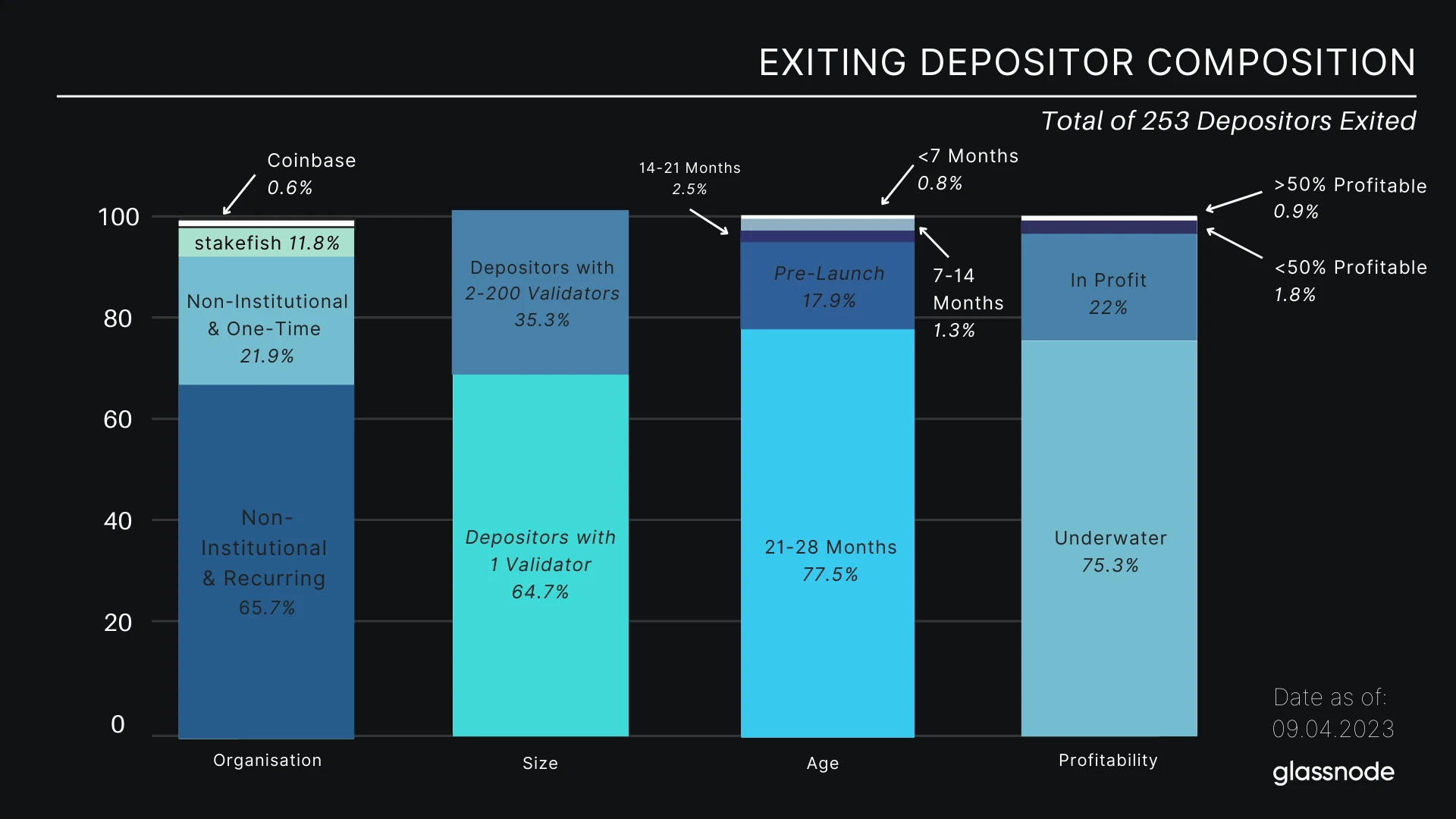
We generally expect that the price pressure from these depositor groups will not be significant. The staking environment has changed dramatically since staking began, and these early individual stakers may be inclined to exit and then redeploy with new staking provider setups to reduce the risks and overhead associated with maintaining staking setups. They may also wish to benefit from new or liquid staking derivatives (LSD) that allow them to maintain their ETH liquidity while still earning Ethereum staking rewards.
Following the SEC's questioning of Kraken's U.S. staking services, Kraken is expected to shut down a significant number of validators. Another potential large-scale exit may come from Celsius Network, as it reportedly plans to sell its staked ETH as part of its bankruptcy proceedings, although it is unlikely that either of these institutions will exit immediately after the upgrade.
Even in the extreme case of a sudden increase in voluntary exits 27 hours before the Shanghai upgrade, we still only see limited increases in staking, which, due to the volatility limit cap, effectively become liquid. We expect that on the day of the Shanghai upgrade, a maximum of 57,600 ETH (109.4 million USD) will be unlocked. If the demand for exits remains high, we will see the same amount of ETH unlocked daily until the volatility limit is readjusted.
In this context, the amount of withdrawals will lead to a dynamic similar to the early days of PoW, when miners' revenues fluctuated within this range (albeit with ETH prices below $1).
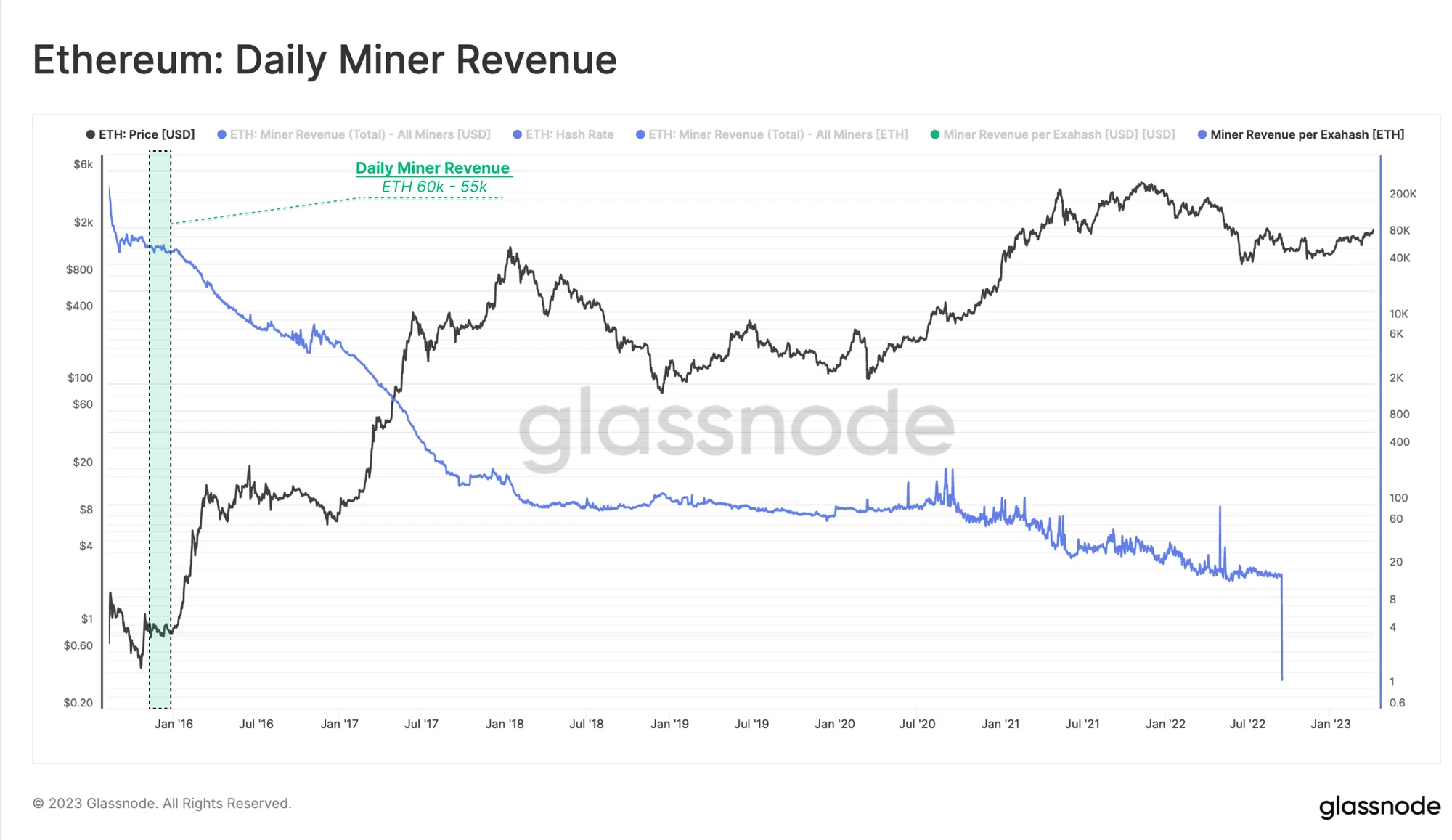
Predictions for Total Supply Impact
Considering both partial and full withdrawals, we can simulate the potential supply pressure in the first week after the Shanghai upgrade. We have three scenarios for staked ETH being unlocked and sold:
- Case 1: In the most extreme scenario, the total accumulated rewards and the maximum amount of staking allowed per week will be extracted and sold, resulting in a total of 1.54 million ETH (2.93 billion USD) becoming liquid assets.
- Case 2: In the current situation, only 0x00 credential holders will receive staking rewards, with 45k ETH being exited and sold, resulting in approximately 312k ETH (592 million USD) becoming liquid assets in the first week.
- Case 3: Our best estimate based on 50% withdrawal credential updates, our segmentation of depositors, and assumptions about investor confidence and profitability. Assuming that the number of exiting validators will double around the Shanghai upgrade, we estimate that a total of 170,000 ETH (323 million USD) will be sold.
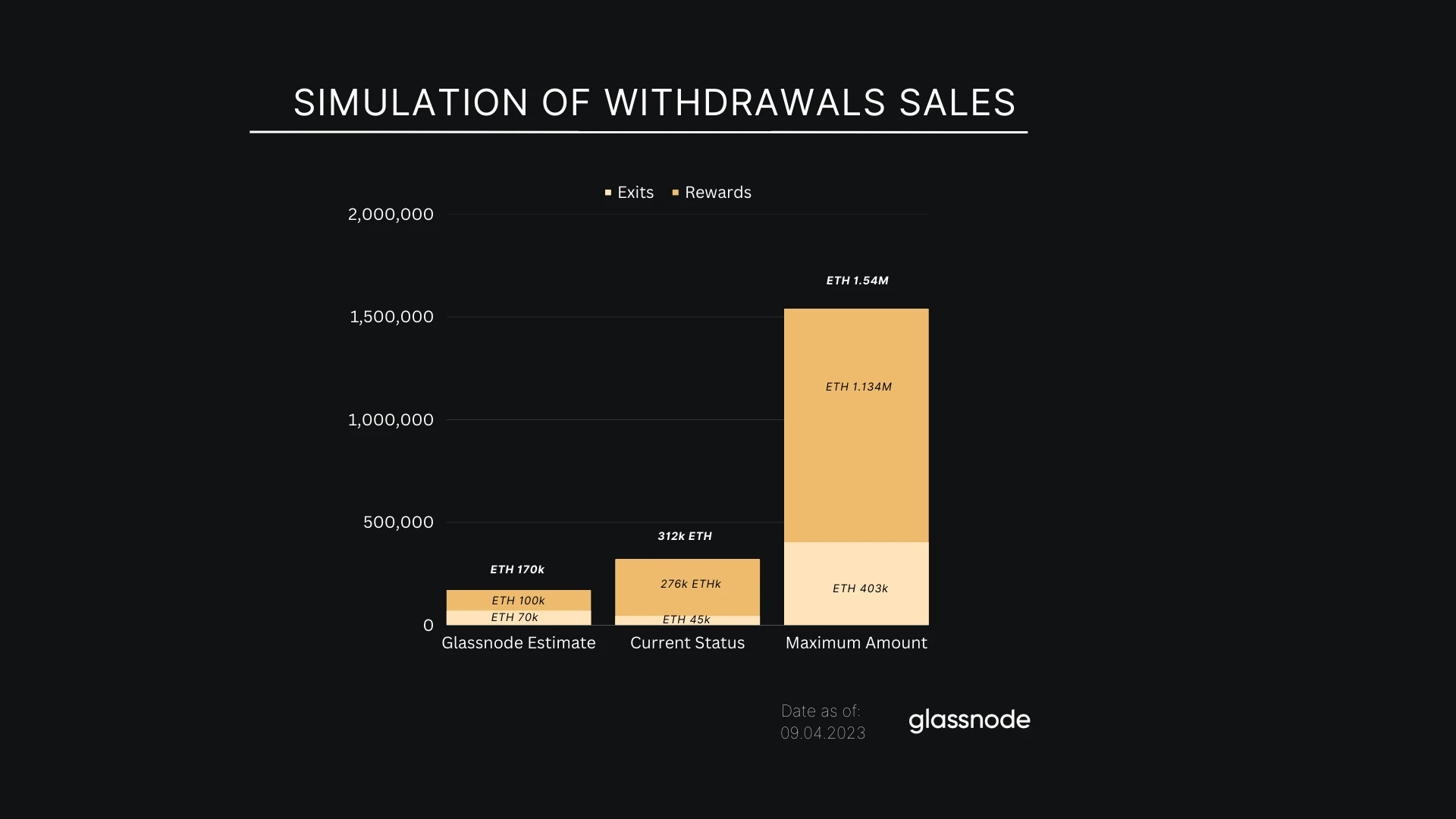
To analyze this more specifically, we can compare it to the typical weekly inflow to exchanges, using examples like the FTX collapse to gauge potential scale. We can see that even in the most extreme case of 1.53 million ETH, it still falls within the range of average weekly inflows to exchanges. In other words, in the most extreme scenario, the average weekly inflow to exchanges would double, which would belong to the scale of recent market adjustments, causing prices to drop by 8.7%, but still far below the inflow scale during the FTX collapse, when prices dropped by 30.2%.
The Shanghai upgrade has been widely publicized, and based on this analysis, the scale of the unlocking event is similar to the daily trading of the ETH market, making it unlikely to be as catastrophic as many have speculated.
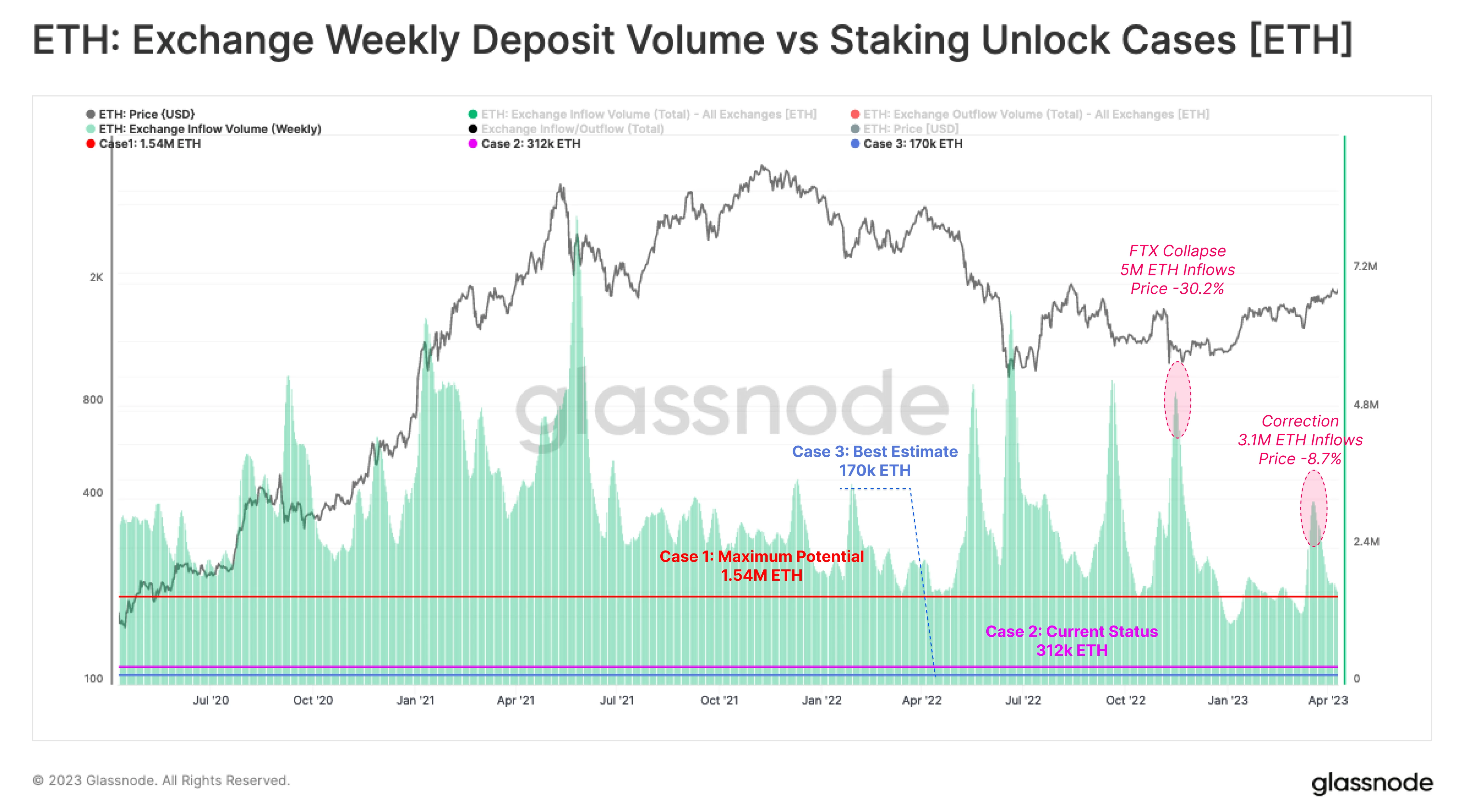
Conclusion
While it is impossible to fully predict the outcomes of the Shanghai upgrade, this analysis attempts to alleviate market anxiety regarding the economic impact of the supply unlocking event.
Even in the extreme case of the maximum amount of rewards and staked ETH being extracted and sold, the sell-side trading volume remains within the range of average weekly forex inflows. Therefore, we conclude that even in the most extreme scenarios, the upgrade's impact on ETH prices remains within an acceptable range for users.









